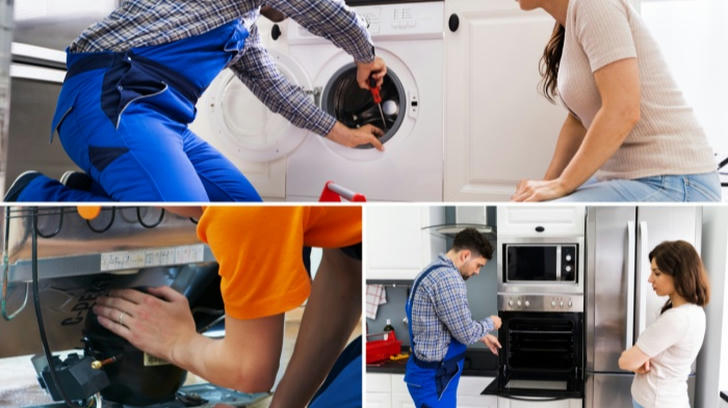The Ultimate Guide to Home Appliance Repair: Saving Time, Money, and the Planet
Home appliances are the unsung heroes of modern life. From washing machines to microwaves, these devices streamline daily tasks, making life more convenient and efficient. However, when they break down, it can feel like a major disruption. Understanding common issues and repair options can help you extend the life of your appliances, save money, and reduce waste. Let’s dive into the world of home appliance repair, backed by data and practical insights.

1. Washing Machine Repair: Keeping Your Laundry Routine on Track
Washing machines are essential for maintaining clean clothes, but they are also prone to wear and tear. According to a 2022 survey by the Association of Home Appliance Manufacturers (AHAM), 68% of households reported experiencing washing machine issues at least once in the past five years. Common problems include:
Failure to spin or drain: Often caused by clogged filters or faulty drain pumps.
Excessive noise: Loose drum bearings or worn-out belts are typical culprits.
Leaks: Damaged hoses or door seals are frequent causes.
Regular maintenance, such as cleaning the detergent drawer and checking hoses, can prevent many of these issues. For example, replacing a worn-out belt costs significantly less than purchasing a new machine, saving both money and resources.
2. Fridge Repair: Preserving Food and Efficiency
Refrigerators are one of the most energy-intensive appliances in the home, accounting for nearly 14% of household electricity use, according to the U.S. Department of Energy. When a fridge malfunctions, it can lead to spoiled food and higher energy bills. Common issues include:
Inadequate cooling: Often due to dirty condenser coils or a faulty thermostat.
Water leakage: Clogged defrost drains or damaged water inlet valves are common causes.
Strange noises: Loose fan blades or compressor issues may be to blame.
Addressing these problems promptly can extend the lifespan of your fridge. For instance, cleaning the condenser coils twice a year can improve efficiency by up to 30%, reducing energy consumption and costs.
3. Dishwasher Repair: Ensuring Spotless Dishes Every Time
Dishwashers save time and water, but they are not immune to breakdowns. A study by Consumer Reports found that 22% of dishwasher repairs are related to drainage issues, while 18% involve heating element failures. Common problems include:
Poor cleaning performance: Clogged spray arms or a malfunctioning pump may be the cause.
Water not draining: Blocked filters or a faulty drain pump are typical issues.
Unpleasant odors: Often due to food debris buildup in the filter or drain.
Regularly cleaning the filter and running a maintenance cycle with vinegar can prevent many of these problems. Repairing a dishwasher pump, for example, is far more cost-effective than replacing the entire unit.
4. Microwave Repair: Quick Fixes for a Kitchen Staple
Microwaves are a convenient tool for heating food, but they can develop issues over time. Data from the National Appliance Service Association (NASA) shows that 40% of microwave repairs are related to the turntable motor, while 30% involve magnetron failures. Common problems include:
Not heating food: A faulty magnetron or diode may be the cause.
Turntable not spinning: Often due to a worn-out motor or broken coupler.
Unusual noises: Loose components or a damaged fan may be to blame.
Repairing a microwave is often straightforward and cost-effective. For example, replacing a turntable motor typically costs less than 20% of the price of a new microwave.
5. Kitchen Appliance Repair: Extending the Life of Your Tools
Kitchen appliances, such as blenders, toasters, and ovens, are vital for meal preparation. However, they can also experience wear and tear. According to a 2021 report by Statista, 35% of consumers repair small kitchen appliances rather than replace them, citing cost savings and environmental concerns. Common issues include:
Blender not working: Often due to a worn-out motor or damaged blades.
Toaster not heating: Faulty heating elements or a broken thermostat may be the cause.
Oven temperature inconsistencies: A malfunctioning thermostat or heating element is often to blame.
Repairing these appliances not only saves money but also reduces electronic waste. For instance, replacing a blender’s motor is significantly cheaper than buying a new one and helps minimize environmental impact.
The Environmental and Financial Benefits of Repairing Appliances
Repairing home appliances is not just about convenience; it’s also a sustainable choice. The Environmental Protection Agency (EPA) estimates that repairing instead of replacing appliances can reduce electronic waste by up to 20%. Additionally, the average cost of repairing an appliance is 50-70% less than purchasing a new one, according to data from HomeAdvisor.
By opting for repairs, you contribute to a circular economy, reducing the demand for raw materials and energy required to manufacture new products. For example, extending the life of a washing machine by five years can save approximately 1,000 kWh of energy, equivalent to powering a home for over a month.
When to Repair vs. Replace
While repairs are often the best option, there are times when replacement makes more sense. Consider the following factors:
Age of the appliance: If your appliance is over 10 years old, replacement may be more cost-effective.
Frequency of repairs: If repairs are becoming frequent, a new appliance might be a better investment.
Energy efficiency: Newer models often consume less energy, leading to long-term savings.
For example, upgrading to an Energy Star-certified refrigerator can save up to $300 in energy costs over its lifetime, according to the U.S. Environmental Protection Agency.
Conclusion: Empowering Yourself with Knowledge
Understanding the basics of home appliance repair can save you time, money, and frustration. By addressing issues early and performing regular maintenance, you can extend the life of your appliances and reduce your environmental footprint. Whether it’s a washing machine, fridge, dishwasher, microwave, or small kitchen appliance, informed decisions about repair and replacement can make a significant difference.
Explore more about how to troubleshoot and maintain your appliances to keep them running smoothly for years to come.
